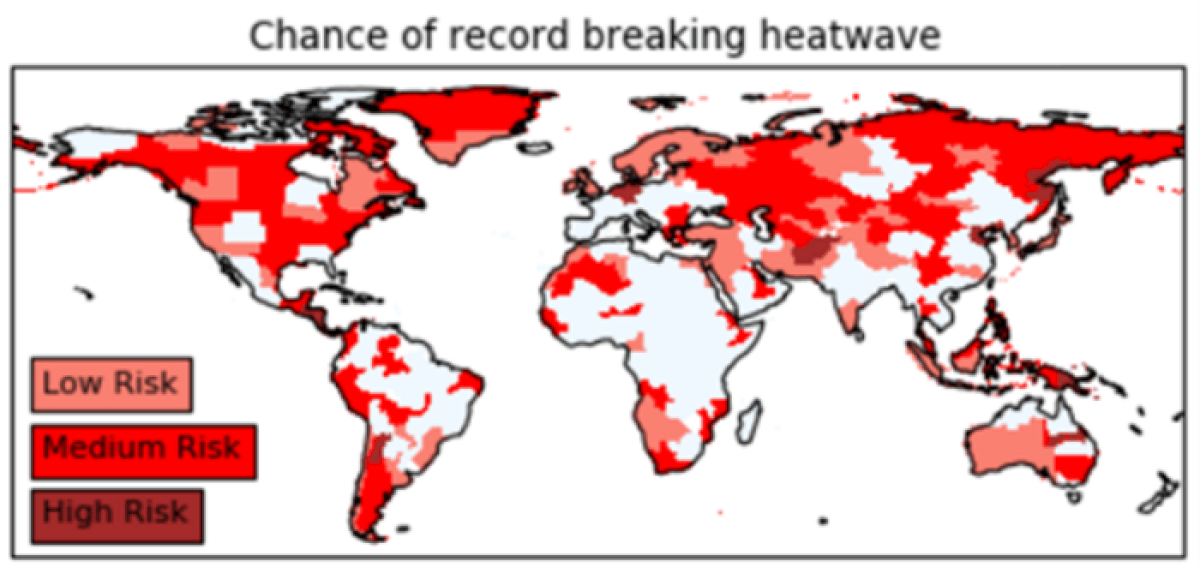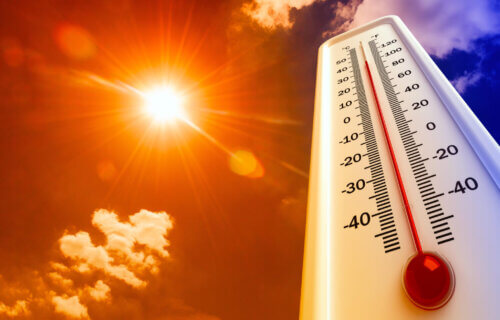BRISTOL, United Kingdom — Earth is heating up. Summers all over the world have become longer and more intense in recent years, with sweltering heatwaves suddenly becoming the new normal. Now, researchers from the University of Bristol have identified regions all over the world that are most vulnerable to the devastating effects of these scorching temperatures.
Researchers explain that these unprecedented heat extremes, in combination with various local socioeconomic vulnerabilities, put certain regions in particular peril. Examples include Afghanistan, Papua New Guinea, and Central America.
Countries that don’t typically experience high temperatures or haven’t dealt with an intense heatwave yet are usually more susceptible. Measures aimed at adapting to the climate in such areas often only go into effect after a heatwave takes place. Additionally, a high chance of record-breaking temperatures, growing populations, and limited healthcare and energy provisioning can increase these risks.
Study authors also point to Beijing and Central Europe as potential hotspots. If record-breaking heatwaves were to occur in such densely populated regions, it would adversely affect millions of people. All in all, researchers are calling for policy makers in so-called hotspot regions to consider and implement relevant action plans that will reduce the risk of deaths and any associated harms from climate extremes.
“As heatwaves are occurring more often we need to be better prepared. We identify regions that may have been lucky so far – some of these regions have rapidly growing populations, some are developing nations, some are already very hot. We need to ask if the heat action plans for these areas are sufficient,” says lead author and climate scientist Dr. Vikki Thompson from the University of Bristol Cabot Institute for the Environment in a media release.

The research team made use of extreme value statistics, a method of estimating the return periods of rare events, for this project. They used large datasets from climate models and observations to pinpoint regions all over the globe where temperature records are most likely to be broken the soonest, with local communities consequently in the greatest danger of experiencing extreme heat.
However, study authors also caution that statistically implausible extremes, in which current records are shattered by temperature margins that seemed impossible until they occurred, can potentially happen anywhere. For instance, these unlikely events have occurred in nearly a third (31%) of analyzed regions where observations were reliable enough between 1959 and 2021.
“Being prepared saves lives. We have seen some of the most unexpected heatwaves around the world lead to heat-related deaths in the tens of thousands. In this study, we show that such record smashing events could occur anywhere. Governments around the world need to be prepared,” explains study co-author Dann Mitchell, Professor in Atmospheric Sciences at the University of Bristol Cabot Institute for the Environment.
In conclusion, study authors believe human-induced climate change is causing an increase in the frequency, intensity, and duration of heatwaves – potentially leading to thousands of avoidable deaths globally. A better understanding of where society may not be ready for climate extremes can help humanity prioritize mitigation in regions deemed most vulnerable.
The study is published in the journal Nature Communications.
Notable heatwaves since 1980:
June 23 – July 7, 1988 – North America: The 1988 North American drought and heatwave caused severe agricultural damage and contributed to more than 5,000 deaths in the United States and Canada.
July 1994 – Southern Europe: A heatwave affected Italy, Spain, and Portugal, causing forest fires and water shortages. Over 3,000 deaths were attributed to the extreme heat.
June 20 – Aug. 10, 2003 – Europe: The 2003 European heatwave led to more than 70,000 excess deaths, particularly affecting elderly populations in France, Italy, Germany, and the United Kingdom. It was one of the deadliest heatwaves in European history.
July 12 – Aug. 31, 2010 – Russia: The 2010 Russian heatwave resulted in a death toll of over 55,000 and caused widespread wildfires, crop failures, and a state of emergency in several regions.
Jan. 2 – 18, 2013 – Australia: The 2013 Australian heatwave broke numerous temperature records, with some locations experiencing temperatures above 120°F.
June 28 – July 7, 2013 – Southwestern United States: The 2013 Southwest United States heatwave caused record high temperatures across the region, with Death Valley reaching 129°F.
July 22 – Aug. 5, 2015 – Middle East: A heatwave affected several countries in the Middle East, with temperatures soaring above 122°F in countries like Iran and Iraq.
May 22 – June 17, 2016 – India and Southeast Asia: The 2016 heatwave in India and Southeast Asia led to more than 2,000 deaths and severely affected agricultural production.
June 17 – Aug. 5, 2018 – Northern Hemisphere: The 2018 heatwave affected multiple regions, including North America, Europe, and Asia, with record-breaking temperatures and numerous wildfires.
June 25 – July 1, 2019 – Europe: The 2019 European heatwave saw temperatures soar above 113°F in countries like France, which experienced its all-time highest temperature of 114.8°F on June 28.
June 26 – July 5, 2021 – Western United States and Canada: The 2021 heatwave brought record high temperatures, with Lytton, British Columbia, in Canada reaching 121.3°F, the highest ever recorded in the country.


Climate scientists have been wrong in their predictions for over 50 years. I expect the tradition to continue.
EXACTLY SO!! The earth has been gradually cooling for 20 years now. Nothing unusual in that. It will probably become warmer later. Again, nothing unusual. We’re talking less that 1°C, either way. It is not forecasting the end of the world. Put a cork in it, Biden and the rest of the loony left!!
Just trust the Science for goodness sake.
1. 1967 Salt Lake Tribune: Dire Famine Forecast by 1975, Already Too Late
2. 1969 NYT: “Unless we are extremely lucky, everyone will disappear in a cloud of blue steam in 20 years. The situation will get worse unless we change our behavior.”
3. 1970 Boston Globe: Scientist Predicts New Ice Age by 21st Century said James P. Lodge, a scientist at the National Center for Atmospheric Research.
4. 1971 Washington Post: Disastrous New Ice Age Coming says S.I. Rasool at NASA.
5. 1972 Brown University Letter to President Nixon: Warning on Global Cooling
6. 1974 The Guardian: Space Satellites Show Ice Age Coming Fast
7. 1974 Time Magazine: Another Ice Age “Telling signs everywhere. Since the 1940s mean global temperatures have dropped 2.7 degrees F.”
Thanks to SUVs the crisis was averted.
Right on!!
A study shows the more people that come to God in Jesus name, the better society becomes, the better the climate becomes, the better homelessness is relieved, the better our politicians govern for the people, the less violence we see, the more polite society, the happier we all become! And, more! Wow!
More UNENDING Fake-news about global warming promoted by the dishonest media. Here’s what these same people were promoting 50 years ago: Remind liberal promoters of their many whacko predictions made by the socialist environmentalists in 1970, the year the “Earth Day” event was invented:
1. Newsweek wrote: A New Ice Age; A World “eleven degrees colder by the year 2000.” (Kenneth Watt);
2. Life Magazine wrote: “By 1985 air pollution will reduce the amount of sunlight reaching earth by one half.”
3. Earth Day founder Gaylord Nelson stated: “By 1995 between 75 and 85 percent of all species to be extinct.”
4. Earth Day organizer Denis Hayes stated: “Mass starvation by 1995.”
18 spectacularly wrong apocalyptic predictions were made at the time of the first Earth Day in 1970. There were even more in 2023.
BooHoo…. 2000 people die in India due to heatwave. Did anyone notice the loss from 1 billion population?